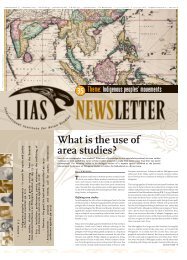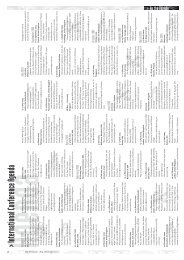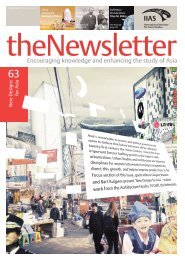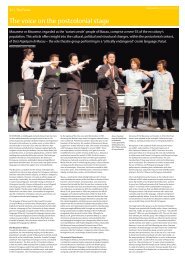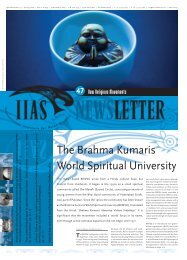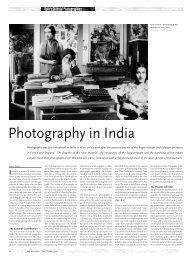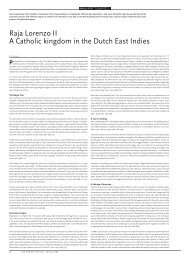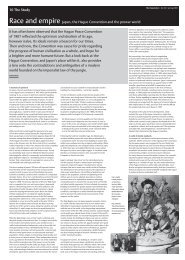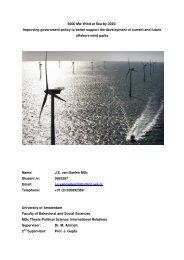Sex, love and revolution - IIAS
Sex, love and revolution - IIAS
Sex, love and revolution - IIAS
Create successful ePaper yourself
Turn your PDF publications into a flip-book with our unique Google optimized e-Paper software.
R E S E A R C H<br />
The decision of Great Britain in the early 1960s to join the European Economic Community provoked a sense of crisis in<br />
Australia, a realisation that it could no longer rely on its membership of the Commonwealth as a defining feature of its place<br />
in the world. If Britain was becoming part of Europe, where could Australia go? Nowhere else, so it would seem, but Asia...<br />
But what kind of proposition is this? How on earth can Australia be part of Asia? Ien Ang uses the 2008 Wertheim Lecture<br />
to shed light on this conundrum.<br />
Asia from ‘Down Under’:<br />
regionalism <strong>and</strong> global cultural change<br />
Ien Ang<br />
As a European settler colony Australia has<br />
historically been regarded as a far-flung<br />
outpost of Europe, ‘down under’ in relation<br />
to the great powers of the West. Looking<br />
at the world map, however, it is evident<br />
that in geographical terms, Australia is<br />
positioned ‘down under’, not to Europe<br />
or America but to Asia. From Australia’s<br />
point of view, Asia is not the ‘Far East’<br />
(as Europeans tend to see Asia), but the<br />
‘Near North’. The fact that the term ‘Far<br />
East’ is still occasionally used in Australia<br />
is testimony to the symbolic power Europe<br />
still has in the global imagination. But it is<br />
a residual power, a legacy of the colonial<br />
<strong>and</strong> imperial past. In modern Australia,<br />
governments have increasingly steered<br />
the country towards closer ties with Asia,<br />
sometimes reluctantly, at other times<br />
enthusiastically, but always with a sense<br />
of urgency.<br />
A complex <strong>and</strong> ambivalent<br />
relationship<br />
As the Western nation-state located in<br />
closest proximity to Asia, Australia provides<br />
an excellent site for observing processes<br />
of global change. Australia’s complex<br />
<strong>and</strong> ambivalent relationship with<br />
Asia can give us fascinating insights into<br />
the contradictory tensions that are associated<br />
with the gradual decentring of the<br />
West, in ways which are still hardly recognised<br />
in Western Europe.<br />
It is hardly contested that the balance of<br />
global power will shift as a consequence<br />
of the growing economies of Asia, especially<br />
China <strong>and</strong> India. This development<br />
has already been keenly felt in Australia. In<br />
the last two decades Australia’s economy<br />
has become increasingly intertwined with<br />
that of its Asian neighbours. For example,<br />
China has recently taken over Japan as Australia’s<br />
largest trading partner, <strong>and</strong> exports<br />
from Australia to China have seen exponential<br />
growth in the past decade. Indeed,<br />
Australia’s long-lasting economic boom in<br />
this period is inextricably linked to China’s<br />
insatiable dem<strong>and</strong> for natural resources<br />
such as coal <strong>and</strong> iron ore, of which Australia<br />
has plenty. Commenting on the potential<br />
impact on the Australian economy of<br />
a recession in the US, one economist said:<br />
“Australia is fine as long as China is fine,<br />
<strong>and</strong> in 2008 China is fine”. (Chris Richardson,<br />
Access Economics director, in Mike<br />
Steketee, ‘Soft L<strong>and</strong>ing’, The Weekend Australian,<br />
March 29-30, 2008.)<br />
There is something ironic about an<br />
advanced, developed nation-state such<br />
as Australia having to rely so much for its<br />
prosperity on being the supplier of raw<br />
materials to a fast-growing non-Western<br />
giant such as China. Yet the Australian<br />
experience may well be the fate of many<br />
national economies in the years to come.<br />
‘Enmesh, integrate <strong>and</strong> engage’<br />
When I relocated from the Netherl<strong>and</strong>s<br />
to Australia in 1991, I left a Europe where<br />
discussion was immersed in the prospect<br />
of an integrated European Union. Arriving<br />
in Australia, however, I noticed that a very<br />
different debate was raging. Australians<br />
did not talk about Europe at all; instead,<br />
all the talk was of Asia. Then Prime Minister<br />
Paul Keating described Australia as “a<br />
multicultural nation in Asia”. Public discourse<br />
in the Keating era was replete with<br />
the need for Australia to ‘enmesh’, ‘integrate’<br />
<strong>and</strong> ‘engage’ with Asia. Educational<br />
policy stressed the importance of teaching<br />
Asian languages in schools, <strong>and</strong> cultural<br />
exchanges with a wide range of East <strong>and</strong><br />
Southeast Asian countries were stepped<br />
up in order to increase what was called<br />
“Asia literacy”.<br />
But these furious attempts at reorienting<br />
Australia towards its Asian neighbours<br />
could not hide the paradoxes of what<br />
James Rosenau calls “distant proximity”<br />
(2003): Australia’s radically different racial,<br />
cultural <strong>and</strong> historical make-up had always<br />
been cause for maintaining psychological<br />
distance rather than closeness to Asia.<br />
As Rosenau puts it, “to a large extent distant<br />
proximities are subjective appraisals<br />
- what people feel or think is remote, <strong>and</strong><br />
what they think or feel is close-at-h<strong>and</strong>”<br />
(Rosenau 2003). Australia’s rapprochement<br />
to Asia, which was primarily motivated<br />
by geopolitical, economic <strong>and</strong> security<br />
reasons, dem<strong>and</strong>ed nothing less than<br />
radical cultural change – <strong>and</strong>, as we know,<br />
cultural change is hard to bring about <strong>and</strong><br />
slow to eventuate.<br />
By 1996, the tide had turned. The new, conservative<br />
government of John Howard rose<br />
to power (where it would stay until 2007)<br />
in the wake of a populist backlash. Rightwing<br />
politician Pauline Hanson managed<br />
to get into parliament with, among others,<br />
a strong anti-Asian agenda. Howard<br />
himself claimed: “We have stopped worrying<br />
about whether we are Asian, in Asia,<br />
enmeshed in Asia or part of a mythical East<br />
Asian hemisphere. We have got on with<br />
the job of being ourselves in the region.”<br />
(John Howard, House of Representatives,<br />
Hansard, 21 September 1999). Howard<br />
steered Australia’s foreign policy strongly<br />
towards an alliance with the US <strong>and</strong> Australia<br />
became an emphatic member of<br />
Bush’s ‘coalition of the willing’. Although<br />
this didn’t spell an end to Australia’s relations<br />
with Asia, the 11 years of Howard<br />
government meant a hugely reduced commitment,<br />
which only now, with the ascendancy<br />
of Kevin Rudd’s new Labor government,<br />
is being overturned.<br />
But first, let’s look from the other side of<br />
the picture. Australia may want to belong<br />
to Asia, but does Asia want Australia?<br />
Former Singaporean PM Lee Kuan Yew<br />
seems to agree with John Howard: Australians<br />
are not Asians. In an interview on<br />
Australian television he said:<br />
But doesn’t Lee essentialise Asianness<br />
too much here? In their book The Myth of<br />
Continents, Martin Lewis <strong>and</strong> Karen Wigen<br />
(1997) observe that “of all the so-called<br />
continents, Asia is not only the largest but<br />
also the most fantastically diversified, a<br />
Dampier iron ore mine in Western Australia. In 2007 Western Australia exported some A$8.5 billionworth<br />
(€5.03 billon) of iron ore to China.<br />
vast region whose only commonalities -<br />
whether human or physical - are so general<br />
as to be trivial”. In short, the boundaries of<br />
Asia are not fixed, <strong>and</strong> there are so many<br />
different peoples <strong>and</strong> cultures within what<br />
we call ‘Asia’ that it would be hard to talk<br />
about distinctly ‘Asian ways’, ‘Asian values’<br />
or indeed ‘Asians’.<br />
Despite the immense internal diversity<br />
of the region, however, Asia does operate<br />
as a powerful, if contested category of<br />
collective identification. A look at some<br />
of the competing designs for transnational<br />
region-building reveals the tensions<br />
involved. Australia was the key initiator of<br />
the establishment of the Asia Pacific Economic<br />
Co-operation (APEC) in 1989 to<br />
promote more effective economic cooperation<br />
across Asia <strong>and</strong> the Pacific Rim.<br />
APEC currently has 21 members, comprising<br />
most countries with a coastline on the<br />
Pacific Ocean. It thus includes not just the<br />
ten Southeast Asian nation-states of the<br />
Association of Southeast Asian Nations<br />
(ASEAN), China, Japan <strong>and</strong> South Korea,<br />
but also, importantly, the US as well as<br />
Canada, New Zeal<strong>and</strong> <strong>and</strong> Australia itself<br />
“Getting close to Asia doesn’t mean that you become<br />
Asians, or you bring Asians into Australia, it just<br />
means underst<strong>and</strong>ing Asians, being able to get on<br />
<strong>and</strong> do business with Asians, making them feel<br />
comfortable with you <strong>and</strong> being comfortable with<br />
them”<br />
(Lee Kuan Yew interviewed by Kerry O’Brien, ABC 7:30 Report, 20 November 2000).<br />
(with other countries including Mexico,<br />
Chile, Russia <strong>and</strong> Papua New Guinea joining<br />
along the way). In cultural terms, APEC<br />
successfully managed to institutionalise a<br />
very broad idea of ‘Asia’, here br<strong>and</strong>ed as<br />
‘Asia Pacific’, <strong>and</strong> suppressing any references<br />
to more particularist, non-white <strong>and</strong><br />
non-Western notions of Asianness. The<br />
well-known group photos of APEC leaders<br />
in the national costume of the host nation<br />
of the regular summits, are a visual display<br />
of this.<br />
But it is good to remember that the initial<br />
proposal for APEC was opposed by<br />
the countries of ASEAN, in particular by<br />
former Malaysian Prime Minister Mathathir,<br />
who instead proposed an East Asia<br />
Economic Caucus, which would only be<br />
open for ‘real’ Asian nations <strong>and</strong> would<br />
exclude countries considered non-Asian.<br />
The plan was strongly opposed <strong>and</strong> criticised<br />
as a “caucus without Caucasians”<br />
by the US, who wished to downplay any<br />
fault line between Asia <strong>and</strong> the West in the<br />
construction of the region. (Mohan Malik,<br />
‘The East Asia Summit: More discord than<br />
Accord’, YaleGlobal Online, 20 December<br />
2005)<br />
Although Mathathir’s Asians-only design<br />
for the region lost out against the Western-led<br />
APEC in the early 1990s, since<br />
the Asian economic crisis of 1997, which<br />
affected many national economies across<br />
the region, the idea of a more specific East<br />
Asian regionalism has gained momentum,<br />
most prominently institutionalised in the<br />
so-called ASEAN+3 forum (which brings<br />
together the 10 ASEAN states <strong>and</strong> China,<br />
Japan <strong>and</strong> South Korea).<br />
Interestingly, this increased emphasis on<br />
‘East Asia’ as the common signifier for<br />
cooperative region-building was motivated<br />
by a desire to reduce Asian dependence<br />
on Western-dominated financial institutions<br />
such as the International Monetary<br />
Fund <strong>and</strong> on the perceived ineffectiveness<br />
of APEC. Indeed, several authors have<br />
observed that an important motive for<br />
this new drive towards East Asian regionalism<br />
was a shared sense of humiliation<br />
<strong>and</strong> resentment against the West’s slow<br />
response to the 1997 economic crisis<br />
(Capie 2004). By contrast, China extended<br />
generous financial support to Thail<strong>and</strong><br />
<strong>and</strong> Indonesia during the crisis, enhancing<br />
its stature as a model of economic stability<br />
<strong>and</strong> responsible leadership (Hugh de<br />
Santis, ‘The Dragon <strong>and</strong> the Tigers: China<br />
<strong>and</strong> Asian Regionalism’, World Policy Journal,<br />
Summer 2005). As Indonesian economist<br />
<strong>and</strong> trade minister Mari Pangestu<br />
observes: “The growth of China led to a<br />
growing realization that the region could<br />
form a large <strong>and</strong> dynamic economic bloc<br />
… <strong>and</strong> seek a more effective voice in the<br />
global arena hitherto dominated by Western<br />
interests.” (Williams, Louise, 2004.<br />
‘We need to be part of Asia’s makeover’,<br />
Sydney Morning Herald, June 28)<br />
East Asia is now a powerful label for active<br />
regional identity making, based at least<br />
in part on the reproduction of the master-division<br />
of ‘Asia’ <strong>and</strong> ‘the West’. In<br />
this dichotomy, Australia is placed firmly<br />
within the second camp. When Australia<br />
requested participation in the 2005 East<br />
Asian Summit, Mahathir, who had retired<br />
as PM of Malaysia in 2003, repeated his<br />
ascerbic anti-Australian views, arguing<br />
that Australia is “some sort of transplant<br />
from another region” (quoted in Robinson,<br />
Jeffrey, 2003. ‘Australia’s Asian ambitions’,<br />
Asian Times Online, 23 October) In<br />
the end, diplomacy won <strong>and</strong> Australia does<br />
now participate in the Summit meetings.<br />
However, Mahathir’s rantings resonate<br />
with the lingering distrust <strong>and</strong> hostility of<br />
Western hegemony throughout the non-<br />
Western world. Complaints about white<br />
supremacy <strong>and</strong> Western arrogance, <strong>and</strong> in<br />
the Australian case, echoes of the White<br />
Australia Policy, are never far below the<br />
surface. They feed feelings of ‘us’ (Asians)<br />
versus ‘them’ (Westerners) which can<br />
be mobilised whenever particular global<br />
events invite a local response.<br />
We can see this taking place when perusing<br />
newspaper coverage of the recent<br />
clashes between pro-Tibet <strong>and</strong> pro-China<br />
protesters during the Olympic torch relay<br />
around the world. Newspapers such as<br />
The Straits Times (Singapore), The Bangkok<br />
Post (Thail<strong>and</strong>) <strong>and</strong> The Times of<br />
India (India) all provided commentary<br />
with careful consideration of the different<br />
sides, but there was criticism of what<br />
was widely perceived as Western media<br />
bias against China. These countries positioned<br />
themselves firmly as Asian nations<br />
within the Asian region, often emphasising<br />
the need to maintain good relations with<br />
their Asian neighbours <strong>and</strong> questioning<br />
the West’s moral authority to lecture the<br />
rest of the world, China included, about<br />
human rights. In this coverage, a clear line<br />
between Asia <strong>and</strong> the West was drawn.<br />
1 8 I I A S N E W S L E T T E R # 4 8 S u m m e r 2 0 0 8



